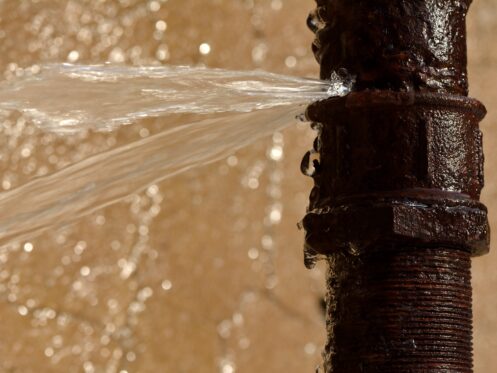When left unfixed, water leaks can compromise the structural integrity of your home. They also present safety and health hazards, such as increasing the risk of slip-and-fall accidents. Fortunately, there are more than a few ways to detect hidden water leaks. Cal’s Plumbing is ready to help you find and fix any leaks in your plumbing system.
1. Check Faucets for Leaks
Start by visually examining each faucet in the home for any signs of dripping or moisture. Check for leaks around the base and handles, too. To detect slow leaks, place a paper towel beneath the faucet overnight. If it’s wet in the morning, you have a leak. Additionally, check for standing water in the lower cabinet or sink of each faucet and make sure all connections are tight. Faucets leak for a number of reasons. As they age, their O-rings and valves wear out, as well as their washers and connections.
2. Look for Damp Spots
Finding concealed water leaks requires a systematic inspection of moist areas. Look for discoloration or water spots on the walls, ceilings, and floors. Use your sense of touch to locate dampness, or consider using a moisture meter. Keep an eye out for mold and mildew development, flaking wallpaper or paint, and other signs of water intrusion. Be wary of musty smells; they may indicate the presence of concealed leaks.
3. Monitor Monthly Water Usage
Compare your current water bills with those from previous months to identify any sudden spikes in consumption. Look for unexplained increases in water usage, as this may indicate a leak. Take time to carefully analyze the usage patterns for consistency and abnormalities. If you discover any abnormalities or sudden spikes, it’s crucial to take immediate action. If you can’t locate the source of the leak, consider hiring a professional plumber to conduct a more detailed assessment.
4. Conduct a Dye Test in Toilets
Another way to find hidden water leaks is to do a dye test in each toilet. Just add a few drops of food coloring to the tank of each toilet, and don’t flush. Check the bowl after 30 minutes. If any of the food coloring seeps into the bowl of the toilet, then there is a leak. The dye test works exceptionally well at pinpointing leaks caused by worn-out flapper valves. Fixing toilet leaks is paramount to conserving water and lowering water bills.
5. Inspect Outdoor Faucets and Irrigation Systems
Inspect all hoses and outdoor faucets for indications of leaks or drips. Water that collects at the base of outdoor faucets, like puddles, might be a sign of a leak somewhere in the plumbing. Check the sprinkler heads for damage or misalignment and the hoses for leaks in the irrigation system. You can walk the path of underground irrigation pipes looking for wet spots.
Turn on the sprinklers, and be on the lookout for any spots that seem unusually wet. Take a moment to make sure the sprinklers spray efficiently. You can help save water and keep your landscape in good condition by fixing exterior faucets and irrigation systems quickly if they leak or stop working.
6. Listen for Running or Dripping Water
Listening for running or dripping water is a simple yet effective method to detect hidden water leaks. Start by turning off all water-using appliances and ensuring no faucets are running. Next, listen carefully near plumbing fixtures, such as sinks, toilets, and showers, for the sound of running water. Pay attention to any dripping sounds, particularly in areas with concealed pipes or plumbing. If you hear running or dripping water when no fixtures are in use, it may indicate a hidden leak. At this point, you’ll want to call us for our water leak detection services.
7. Check for Underground Leaks
Water leaks are sometimes hidden far beyond sight. This is why it’s important to check the property for underground leaks. You can do this by visually examining the landscape for areas of unusually lush or damp vegetation, which may indicate underground leaks. If you suspect a leak in a certain area, consider hiring a professional. Our plumbers are equipped with specialized tools, such as acoustic listening devices or infrared cameras, for more accurate detection.
8. Inspect Caulking Around Tubs and Sinks
Caulking plays a vital role in protecting your home against water leaks. As time passes, though, this water-sealant will start to age. To find weak spots, look for areas that seem loose or mushy by carefully probing the caulking with your fingertips or a putty knife. Also, run some water in the sink or tub and look for signs of water seepage or dampness around the caulking. Repair damaged caulking immediately by removing the old, thoroughly cleaning the area, and applying fresh to ensure a watertight seal.
9. Check Water-Using Appliances for Leaks
To check water-using appliances for leaks, start by visually inspecting the area around the appliance for any signs of water accumulation or staining. Examine hoses, connections, and seals for wear, damage, and corrosion. Run each appliance through a regular cycle and monitor for any leaks or drips during operation. For dishwashers and washing machines, check for leaks underneath the appliance and around the door seals. Inspect the water supply lines, valves, and drain pipes for any signs of leaks or moisture.
10. Monitor the Performance of Sump Pumps
Keep an eye on sump pumps by visually inspecting them and their surroundings on a regular basis to detect any concealed water leaks. Be sure to look for standing water or dampness in the area around the sump pump. If you hear any grinding or rattling, it might be a sign that the pump isn’t working properly.
To check its functioning, fill the sump pit with water and watch the pump turn on and off. See to it that the pump efficiently pumps out the water from the pit. Double-check that the float switch activates the unit as it should. For your peace of mind, we can install a backup sump pump in case the main pump fails, or there is excessive water collection.
11. Install Leak Detectors
You have several leak detector options to choose from. Passive detectors trigger alerts upon detecting excess moisture or water accumulation. Active detectors interface with home automation systems and send alerts to smartphones or tablets. Flow-based detectors monitor water flow in pipes, automatically shutting off the water supply upon detecting a leak. Utilizing these detectors offers early detection of leaks and helps mitigate costly water damage risks.
Cal’s Plumbing knows all about finding and fixing hidden water leaks. We specialize in emergency plumbing, slab leak repairs, drain cleaning, water heaters, water conditioners, and much more. We pride ourselves on our honesty. We offer upfront flat rates, so you won’t have any surprises on your final bill. To prevent leaks or detect them early, consider our plumbing inspection services. If you suspect a water leak in your Tucson, AZ, home, contact Cal’s Plumbing today.





